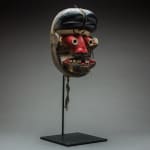Colonial Gere (We) Polychrome Mask, 1900 CE - 1950 CE
Wood
height 24.8 cm
height 9 3/4 in
height 9 3/4 in
LSO.246
Further images
The Gere (also known as the We or Gwere) of the SW Ivory Coast are associated with the Dan to such an extent that their artworks are sometimes referred to...
The Gere (also known as the We or Gwere) of the SW Ivory Coast are associated with the Dan to such an extent that their artworks are sometimes referred to as Dan-Gere. Some of their material culture – notably their masks – are also associated with the Bete. Their dynamic social context, based primarily in the forests unlike the savannah-dwelling Dan, has given rise to a highly diverse and organic material culture that evokes forest spirits and dead ancestors through the intermediary of magico-religious rituals. This was managed through usage of the so called “terror” mask, which may be decorated with horns, leaves, shells, metal studs and other paraphernalia, and which is designed to assist dead ancestors to establish contact with tutelary entities from the hereafter. There are various forms of this mask, but the majority possess extensive superstructures that are absent in the current example. This is partly attributable to regional variability in mask design, but primarily due to the sudden availability of western paints that arrived with the influx of European settlers and traders.
The sculptural effects of the terror mask are still visible, but rather than cover the face with horns and accessories the major divisions of the mask have been indicated with red, white, blue and black paint. The forehead section is prognathic, like the original terror mask, and it has the same recessed face with eye slits, and protuberant nose. The fact that the horns by the eyes have been reduced to stumps (highlighted with trefoil designs in white) mean that the eyes can be raised from the face, standing clear of the background by merit of being highlighted in white.
Their impact would have been further heightened by the inclusion of glass discs, fragments of which are still visible in the masks’ right eye. The nose is a broad trefoil shape. The mouth gapes, exposing bared teeth – a signal of aggression or even insanity in many artistic traditions. One might assume that possession by spirits would also merit such a characteristic. The tongue, painted bright red, protrudes from between black lips, the cheeks accentuated by further trefoil eminences at the corners of the mouth. The impact of the mask is heightened further by the addition of a black and white moustache (possibly the hair from a black and white colobus monkey) and a further pair of long, drooping fronds that attach just below the eyes. The mask is pierced around the circumference to allow the attachment of a cloth or raffia tunic, and remains of textile straps are still joined to the sides of the mask. There is also a metal suspension loop integrated into the apex. This is a remarkable and impactive mask.
The sculptural effects of the terror mask are still visible, but rather than cover the face with horns and accessories the major divisions of the mask have been indicated with red, white, blue and black paint. The forehead section is prognathic, like the original terror mask, and it has the same recessed face with eye slits, and protuberant nose. The fact that the horns by the eyes have been reduced to stumps (highlighted with trefoil designs in white) mean that the eyes can be raised from the face, standing clear of the background by merit of being highlighted in white.
Their impact would have been further heightened by the inclusion of glass discs, fragments of which are still visible in the masks’ right eye. The nose is a broad trefoil shape. The mouth gapes, exposing bared teeth – a signal of aggression or even insanity in many artistic traditions. One might assume that possession by spirits would also merit such a characteristic. The tongue, painted bright red, protrudes from between black lips, the cheeks accentuated by further trefoil eminences at the corners of the mouth. The impact of the mask is heightened further by the addition of a black and white moustache (possibly the hair from a black and white colobus monkey) and a further pair of long, drooping fronds that attach just below the eyes. The mask is pierced around the circumference to allow the attachment of a cloth or raffia tunic, and remains of textile straps are still joined to the sides of the mask. There is also a metal suspension loop integrated into the apex. This is a remarkable and impactive mask.







